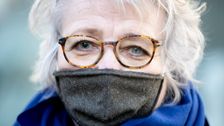
The coronavirus pandemic has created an unprecedented demand for face masks in the medical profession, as millions of masks are needed to protect the doctors, nurses and other health care workers who treat COVID-19 patients. Sewers around the world have been doing their best to produce masks that can be donated to local hospitals, following tutorials for how to sew a face mask that’s effective against the coronavirus.
But soon, those of us not in the health care profession may need masks for ourselves.
Until recently, the World Health Organization has urged that if you’re healthy, you only need to wear a mask if you’re taking care of a person suspected of having COVID-19, or if you’re coughing or sneezing. However Neil Fishman, the chief medical officer of the Hospital of the University of Pennsylvania, told The New York Times that “for individuals working in certain essential industries, where they still have to go out every day, I think wearing a mask makes sense.” And now, The Washington Post reports that the Centers for Disease Control and Prevention is considering recommending the general public wear face masks when they’re out and about.
In light of the medical profession’s shortage of face masks, it’s imperative that those of us who can should refrain from buying the masks our health care workers so badly need. The next best option is making our own, and since many of us either don’t know how to sew or don’t have access to sewing supplies, no-sew DIY face masks are the best option.
A little background on DIY face masks for coronavirus
There are two types of face masks that can help cut your odds of getting coronavirus: N95 masks, which are tight-fitting and medical grade, and then surgical face masks ― the ones featured in the tutorials below ― which are loose-fitting and relatively thin.
Surgical masks aren’t ideal for hospital use with COVID-19 because they allow tiny droplets to seep in through parts of the mask, but they’re helpful for those of us venturing out in public to buy groceries or run errands.
A study of homemade face masks by SmartAirFilters.com found that cotton T-shirts and cotton pillowcases are the best at-home materials for making DIY face masks, based on their ability to capture particles yet remain breathable, and that they perform comparably to surgical-grade masks.
The WHO reminds us that masks are only effective when they’re used in combination with frequent and proper hand-washing. And if you do wear a mask, you must know how to use it and dispose of it properly.
And of course, follow all of your local protocols and avoid leaving the house unless it’s absolutely necessary.
Tutorials for no-sew face masks
We’ve gathered several no-sew mask tutorials that require very few crafting skills and can be used for your personal protection. Keep in mind that the edges of the mask should fit snuggly against the skin. Read through the tutorials and choose one that best suits you.
Credit: Source link